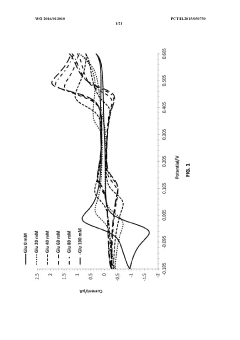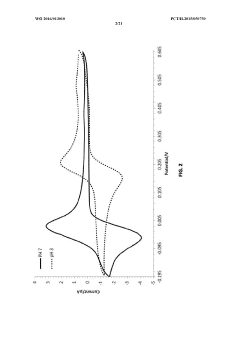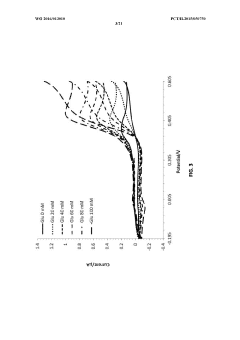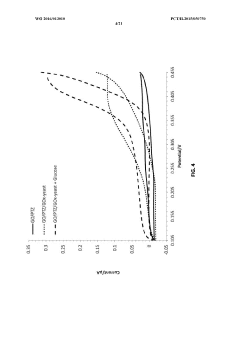How to Develop Safer Electronics with Graphene Oxide?
Graphene Oxide Safety in Electronics: Background and Objectives
Graphene oxide has emerged as a revolutionary material in the field of electronics, offering unprecedented opportunities for developing safer and more efficient devices. The evolution of graphene oxide technology can be traced back to the early 2000s when researchers first isolated graphene, a single layer of carbon atoms arranged in a hexagonal lattice. Graphene oxide, a derivative of graphene, soon gained attention due to its unique properties and potential applications in various fields, including electronics.
The primary objective of incorporating graphene oxide into electronics is to enhance safety while maintaining or improving performance. This goal is driven by the increasing demand for safer electronic devices, particularly in sensitive applications such as medical implants, wearable technology, and aerospace systems. Graphene oxide's exceptional thermal conductivity, electrical properties, and mechanical strength make it an ideal candidate for addressing safety concerns in electronic components.
One of the key trends in graphene oxide technology is its integration into battery systems. The material's high surface area and excellent conductivity properties offer the potential for developing safer, more efficient, and longer-lasting batteries. This is particularly crucial in the context of electric vehicles and portable electronic devices, where battery safety is paramount.
Another significant trend is the use of graphene oxide in electromagnetic shielding. As electronic devices become more compact and powerful, the risk of electromagnetic interference increases. Graphene oxide's ability to absorb electromagnetic radiation effectively makes it an excellent material for developing safer electronics that are less susceptible to interference and potential malfunctions.
The development of graphene oxide-based sensors is also gaining momentum in the pursuit of safer electronics. These sensors can detect a wide range of environmental factors, including temperature, humidity, and potentially harmful gases. By incorporating such sensors into electronic devices, manufacturers can create systems that are more responsive to potential safety hazards, thereby enhancing overall device safety.
As we look towards the future, the integration of graphene oxide in flexible and wearable electronics presents exciting possibilities for safer device designs. The material's flexibility and durability could lead to the development of electronics that are less prone to physical damage and more adaptable to various environmental conditions.
In conclusion, the background and objectives of graphene oxide in electronics safety are rooted in the material's unique properties and the growing demand for safer electronic devices. As research continues to advance, we can expect to see more innovative applications of graphene oxide that push the boundaries of electronic safety and performance.
Market Demand for Safer Electronic Materials
The market demand for safer electronic materials has been steadily increasing in recent years, driven by growing concerns over the environmental impact and health risks associated with traditional electronic components. As consumers become more environmentally conscious and regulatory bodies impose stricter safety standards, manufacturers are actively seeking innovative materials that can enhance the safety profile of electronic devices without compromising performance.
Graphene oxide, a derivative of graphene, has emerged as a promising candidate for developing safer electronics. Its unique properties, including high thermal conductivity, excellent mechanical strength, and potential for functionalization, make it an attractive option for various electronic applications. The market for graphene-based materials in electronics is projected to grow significantly, with some estimates suggesting a compound annual growth rate of over 30% in the coming years.
One of the key drivers for the adoption of graphene oxide in electronics is its potential to replace hazardous materials commonly used in electronic components. For instance, the replacement of lead-based solders with graphene oxide-based alternatives could significantly reduce the environmental impact of electronic waste. This aligns with the global push towards lead-free electronics, as mandated by regulations such as the European Union's Restriction of Hazardous Substances (RoHS) directive.
The demand for safer electronic materials is particularly pronounced in consumer electronics, where direct user interaction raises concerns about exposure to potentially harmful substances. Manufacturers of smartphones, tablets, and wearable devices are exploring graphene oxide-based solutions for improved battery safety, heat dissipation, and electromagnetic shielding. This trend is further amplified by the growing market for Internet of Things (IoT) devices, which requires the development of compact, energy-efficient, and safe electronic components.
In the automotive sector, the shift towards electric vehicles has created a substantial market for safer and more efficient electronic materials. Graphene oxide's potential applications in battery technology, lightweight composites, and thermal management systems align well with the industry's goals of improving vehicle safety and performance. As the automotive industry continues to electrify, the demand for advanced materials like graphene oxide is expected to surge.
The healthcare and medical device industries also present significant opportunities for safer electronic materials. With the increasing integration of electronics in medical devices and implants, there is a critical need for biocompatible materials that can ensure patient safety while delivering advanced functionalities. Graphene oxide's biocompatibility and potential for surface modification make it an attractive option for developing next-generation medical electronics.
As research and development efforts intensify, and production processes for graphene oxide become more scalable and cost-effective, its adoption in electronic applications is likely to accelerate. This growing market demand is driving investments in graphene oxide technology and creating opportunities for both established electronics manufacturers and innovative startups to develop safer, more sustainable electronic products.
Current Challenges in Graphene Oxide Electronics
Despite the promising potential of graphene oxide in electronics, several significant challenges currently hinder its widespread adoption and implementation. One of the primary obstacles is the lack of standardization in production methods, leading to inconsistencies in the quality and properties of graphene oxide materials. This variability makes it difficult for manufacturers to achieve reliable and reproducible results in electronic applications.
Another major challenge lies in the scalability of graphene oxide production. While laboratory-scale synthesis has shown promising results, scaling up to industrial levels while maintaining quality and cost-effectiveness remains a significant hurdle. This limitation impacts the ability to integrate graphene oxide into large-scale electronic manufacturing processes.
The stability of graphene oxide in various environmental conditions poses another critical challenge. Graphene oxide's sensitivity to humidity and temperature fluctuations can lead to performance degradation over time, affecting the long-term reliability of electronic devices. Addressing this issue requires the development of effective encapsulation techniques or the modification of graphene oxide to enhance its environmental stability.
Furthermore, the integration of graphene oxide with existing silicon-based technologies presents compatibility issues. Developing seamless integration methods that do not compromise the performance of either graphene oxide or silicon components is crucial for the advancement of hybrid electronic systems.
The electrical properties of graphene oxide, while promising, also present challenges. The material's variable bandgap and conductivity, which depend on the degree of oxidation, make it difficult to achieve consistent electronic performance across different batches or applications. Fine-tuning these properties for specific electronic functions remains an active area of research.
Safety concerns also persist in the use of graphene oxide in electronics. The potential release of nanoparticles during the manufacturing process or throughout the lifecycle of electronic devices raises questions about long-term health and environmental impacts. Developing safer handling protocols and assessing the material's biocompatibility are essential steps in addressing these concerns.
Lastly, the cost of high-quality graphene oxide production remains a significant barrier to its widespread adoption in consumer electronics. While the material itself is derived from abundant carbon sources, the processes required to produce electronics-grade graphene oxide are often complex and expensive. Reducing production costs while maintaining quality is crucial for making graphene oxide-based electronics commercially viable.
Existing Safety Solutions for Graphene Oxide in Electronics
01 Safety assessment and toxicity studies of graphene oxide
Research focuses on evaluating the safety and potential toxicity of graphene oxide through various studies and assessments. These investigations aim to understand the potential health and environmental impacts of graphene oxide exposure, including its effects on living organisms and ecosystems.- Safety assessment and toxicity studies of graphene oxide: Research focuses on evaluating the safety and potential toxicity of graphene oxide through various studies and assessments. These investigations aim to understand the biological effects and potential health risks associated with graphene oxide exposure, informing its safe use in different applications.
- Environmental impact and biodegradation of graphene oxide: Studies examine the environmental fate and biodegradability of graphene oxide to assess its long-term impact on ecosystems. This research aims to develop environmentally friendly production methods and applications while minimizing potential ecological risks.
- Safe handling and protective measures for graphene oxide: Development of protocols and guidelines for the safe handling, storage, and disposal of graphene oxide in research and industrial settings. This includes the design of personal protective equipment and engineering controls to minimize exposure risks during production and use.
- Biocompatibility and medical applications of graphene oxide: Investigation of the biocompatibility of graphene oxide for potential medical applications, including drug delivery systems and tissue engineering. Research focuses on optimizing the properties of graphene oxide to enhance its safety and efficacy in biological systems.
- Functionalization and modification for improved safety: Development of methods to functionalize or modify graphene oxide to enhance its safety profile and reduce potential risks. This includes surface modifications, encapsulation techniques, and the creation of hybrid materials to mitigate toxicity concerns while maintaining desired properties.
02 Development of safe production methods for graphene oxide
Efforts are directed towards developing and improving production methods for graphene oxide that prioritize safety. These methods aim to minimize potential hazards during manufacturing processes and reduce the risk of exposure to harmful substances.Expand Specific Solutions03 Environmental impact and biodegradation of graphene oxide
Studies investigate the environmental fate and potential biodegradation of graphene oxide. This research aims to understand how graphene oxide interacts with various ecosystems and assess its long-term impact on the environment.Expand Specific Solutions04 Safe handling and disposal protocols for graphene oxide
Development of guidelines and protocols for the safe handling, storage, and disposal of graphene oxide. These measures aim to minimize risks associated with exposure and ensure proper management throughout the material's lifecycle.Expand Specific Solutions05 Applications of graphene oxide in safety-related technologies
Exploration of potential applications of graphene oxide in various safety-related technologies. This includes the development of protective materials, sensors, and other innovations that leverage the unique properties of graphene oxide to enhance safety in different fields.Expand Specific Solutions
Key Players in Graphene Oxide Electronics Industry
The development of safer electronics using graphene oxide is in an emerging phase, with significant market potential due to the increasing demand for advanced electronic materials. The global graphene market is projected to grow rapidly, driven by applications in electronics and energy storage. While the technology is still evolving, several key players are making strides in research and development. Companies like Samsung Electronics Co., Ltd. and Toray Industries, Inc. are at the forefront, leveraging their expertise in electronics and materials science. Research institutions such as Centre National de la Recherche Scientifique and Rensselaer Polytechnic Institute are contributing to fundamental advancements. Emerging players like Archer Materials Ltd. and Vorbeck Materials Corp. are focusing on specialized applications, indicating a diverse and competitive landscape in this promising field.
Samsung Electronics Co., Ltd.
Toray Industries, Inc.
Innovations in Graphene Oxide Safety Technologies
- A hydro-solvo-thermal method using oak fruit as a natural source of potassium to synthesize potassium-doped graphene oxide, involving solvothermal grinding, centrifugation, and nano-filtration to produce high-quality, biocompatible graphene oxide for bio-sensing and bio-imaging.
- A composite comprising graphene oxide and phenothiazine (PTZ) is used to mediate electron transfer between glucose oxidase or glucose dehydrogenase and an electrode, enhancing the electrical signal and enabling a novel hybrid biosensor and extended release dosage form.
Environmental Impact of Graphene Oxide in Electronics
The integration of graphene oxide (GO) into electronic devices has raised significant environmental concerns, necessitating a comprehensive assessment of its potential impacts. GO's unique properties, while beneficial for electronic applications, may pose risks to ecosystems and human health if not properly managed throughout the product lifecycle.
During the production phase, the synthesis of GO often involves the use of strong oxidizing agents and acids, which can lead to the generation of hazardous waste. Proper disposal and treatment of these byproducts are crucial to prevent soil and water contamination. Additionally, the energy-intensive nature of GO production contributes to increased carbon emissions, highlighting the need for more sustainable manufacturing processes.
In the usage phase, the stability of GO in electronic devices is a key consideration. While GO is generally stable under normal operating conditions, extreme temperatures or mechanical stress may cause degradation, potentially releasing nanoparticles into the environment. The long-term effects of such releases on ecosystems and human health are not yet fully understood, emphasizing the importance of ongoing research in this area.
End-of-life management of GO-containing electronics presents another environmental challenge. Conventional recycling methods may not be suitable for effectively recovering and safely disposing of GO materials. Improper disposal can lead to the accumulation of nanomaterials in landfills or their release into water systems, potentially affecting aquatic life and entering the food chain.
To mitigate these environmental risks, several strategies can be implemented. Developing green synthesis methods for GO production, such as using renewable reducing agents and minimizing the use of harsh chemicals, can significantly reduce the environmental footprint of manufacturing processes. Improving the stability and encapsulation of GO in electronic devices can prevent unintended release during use and disposal.
Furthermore, establishing specialized recycling and disposal protocols for GO-containing electronics is essential. This may involve the development of new technologies for the safe extraction and reuse of GO materials, as well as the implementation of extended producer responsibility programs to ensure proper end-of-life management.
Ongoing environmental monitoring and toxicological studies are crucial to fully understand the long-term impacts of GO on ecosystems and human health. This research will inform the development of regulatory frameworks and industry standards for the safe use and disposal of GO in electronics, ensuring that the benefits of this innovative material can be realized without compromising environmental sustainability.
Regulatory Framework for Nanomaterials in Electronics
The regulatory framework for nanomaterials in electronics is a complex and evolving landscape that aims to ensure the safe development, production, and use of nanomaterials in electronic devices. As graphene oxide gains prominence in the electronics industry, it is crucial to understand the current regulatory environment and its implications for manufacturers and consumers.
At the international level, organizations such as the Organization for Economic Co-operation and Development (OECD) and the International Organization for Standardization (ISO) have been working to establish guidelines and standards for nanomaterials. The OECD's Working Party on Manufactured Nanomaterials (WPMN) has developed a comprehensive framework for assessing the safety of nanomaterials, including those used in electronics.
In the European Union, the Registration, Evaluation, Authorization, and Restriction of Chemicals (REACH) regulation is the primary legislation governing the use of nanomaterials. REACH requires manufacturers and importers to register substances, including nanomaterials, and provide safety information. The European Chemicals Agency (ECHA) has also published specific guidance for nanomaterials under REACH.
In the United States, the Environmental Protection Agency (EPA) regulates nanomaterials under the Toxic Substances Control Act (TSCA). The EPA has implemented reporting and recordkeeping requirements for companies that manufacture or process nanoscale materials, including those used in electronics. Additionally, the Food and Drug Administration (FDA) has jurisdiction over nanomaterials in products that fall under its purview, such as medical devices.
Specific to electronics, the Restriction of Hazardous Substances (RoHS) Directive in the EU and similar regulations in other regions limit the use of certain hazardous substances in electrical and electronic equipment. While nanomaterials like graphene oxide are not currently explicitly covered by RoHS, future amendments may address their use as the technology becomes more prevalent.
As the field of nanotechnology continues to advance, regulatory bodies are working to keep pace with new developments. This includes efforts to standardize testing methods for nanomaterials and to establish clear guidelines for their safe use in electronics. Manufacturers must stay informed about these evolving regulations to ensure compliance and maintain consumer trust in their products.







